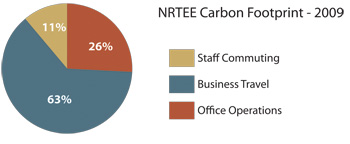Our Carbon Footprint
As a key element of its greening initiative, the NRTEE has instituted procedures to measure and track its carbon footprint on an ongoing basis, starting with the 2008 calendar year. This involves performing an inventory of the greenhouse gas emissions emitted from office space energy use, business travel and employee commuting, and then applying standard, recognized steps to calculate the footprint.* The approach is consistent, to the extent possible, with the requirements and recommendations of the WRI/WBCSD GHG Protocol, and is checked and verified by an independent organization.
The information generated by the annual GHG inventory highlights opportunities for the NRTEE to reduce or avoid energy use in its operations.
NRTEE’S CARBON FOOTPRINT
From January 1st to December 31st 2010 (inclusive), the NRTEE’s carbon footprint was 159 metric tonnes CO2e (carbon dioxide equivalents). This represents a significant and absolute reduction in emissions over 2009 levels.
Table 1: Summary of NRTEE GHG Inventory – 2008 to 2010
| Activity | 2008 | 2009 | 2010 | |||
|---|---|---|---|---|---|---|
| Carbon Footprint (tonnes CO2e) | % of Total | Carbon Footprint (tonnes CO2e) | % of Total | Carbon Footprint (tonnes CO2e) | % of Total | |
| Office Operations | 46 | 18% | 46 | 26% | 37 | 23% |
| Business Travel | 187 | 75% | 111 | 63% | 91 | 57% |
| Employee Commuting | 18 | 7% | 18 | 11% | 31 | 19% |
| Total | 251 | 100% | 175 | 100% | 159 | 100% |
Figure 1: NRTEE Carbon Footprint – 2010
Figure 2: NRTEE Carbon Footprint – 2009
Figure 3: NRTEE Carbon Footprint – 2008
THE NRTEE’S BUSINESS TRAVEL
Business travel is a core and indispensable activity for the NRTEE. The business travel included in the footprint calculation includes travel undertaken by Secretariat staff, NRTEE members, stakeholders and Canadians with whom we meet.
Most of the business travel is by air within Canada, with an occasional international flight. The remainder of the business travel is by rail or by car (either directly or as a transfer between airports or railway stations and a specific venue at the destination).
——————————-
* Annual electricity, heating and cooling energy consumption data is collected from utility bills. Business travel data is collected from expense claims.




























